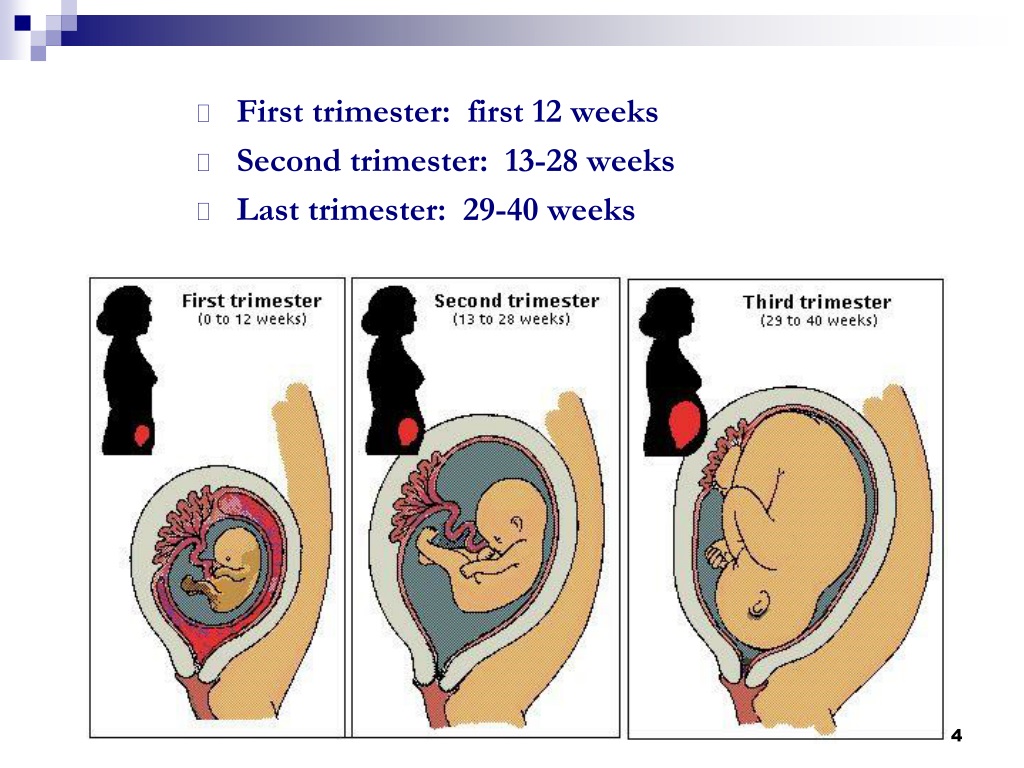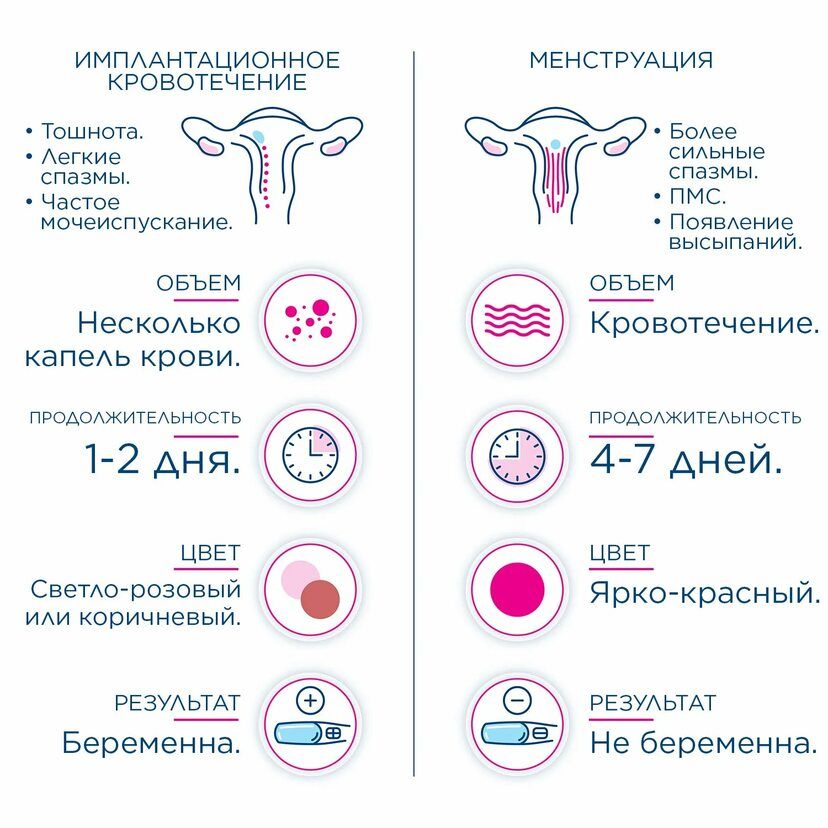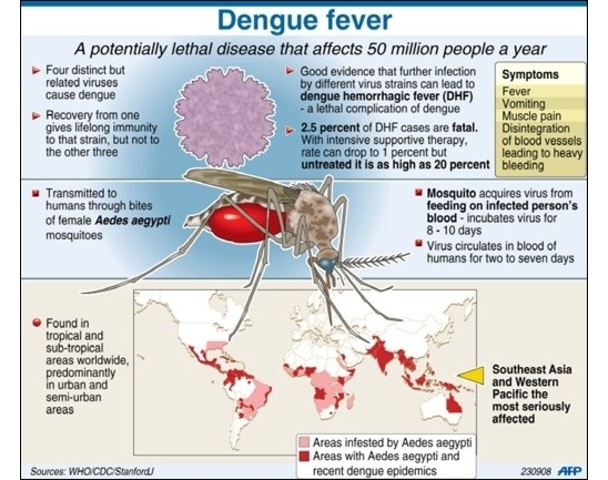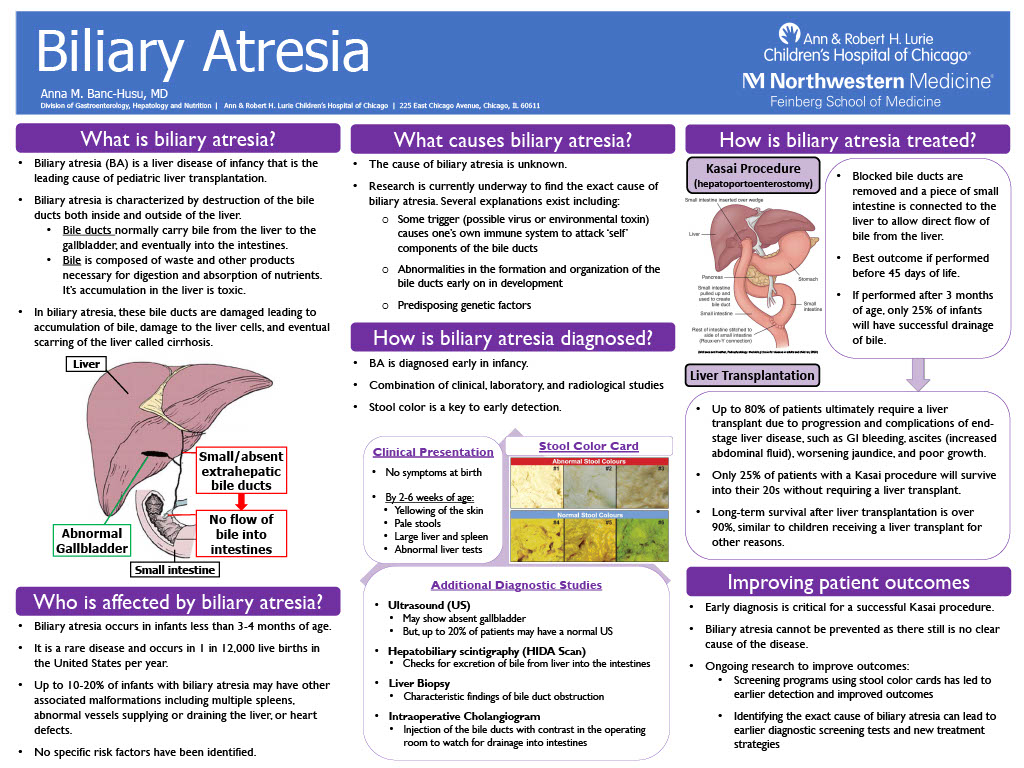Uncomfortable pregnancy second trimester
What you can expect in your second trimester of pregnancy
You’ve just cleared a major hurdle and it’s time to celebrate – you’re into your second trimester! The second trimester generally lasts from week 14 to week 27 of pregnancy. (If you haven’t already shared your baby news with everyone, now might be the time to execute that baby announcement you’ve been eyeing on Pinterest.)
It’s during your second trimester that your growing baby bump will begin to pop out for the world to see. Your body will experience this and many more changes in your second trimester. Here’s a rundown of some symptoms and other milestones you can expect.
Second trimester symptoms
As you enter the next 13 weeks, you may notice these changes:
Decreased morning sickness
If you experienced morning sickness in your first trimester, then you’re in luck – you’re probably going to experience less nausea in the second trimester. It’s not likely that morning sickness will come back in the second trimester, which means your appetite – and your energy – may return. But keep in mind that nausea could last for a few weeks into the second trimester, so you may need to keep drinking that ginger tea for just a bit longer.
Difficulty eating large meals
Your growing uterus might make it harder to eat larger meals. Instead, try to nibble on smaller amounts of food throughout the day. If you experienced morning sickness, you may already be used to this. Remember, you should be eating around 200 to 300 extra calories each day. You’ll feel better when you make healthy food choices, like lean proteins and complex carbohydrates. Fat takes more time to digest so it sits in your stomach longer, which can lead to constipation.
Increased energy
You’ll most likely feel less fatigued from pregnancy throughout the day, giving you more energy to do things you enjoy, like starting a baby registry. Make sure you get out and move, too. We recommend 30 minutes of activity a day such as walking, joining an exercise class, biking or swimming. Just stay away from activities that have a higher risk of injury (skiing – water or downhill, roller coasters, horseback riding, etc.). Be careful not to bump, injure or fall on your belly.
Just stay away from activities that have a higher risk of injury (skiing – water or downhill, roller coasters, horseback riding, etc.). Be careful not to bump, injure or fall on your belly.
Some women still experience fatigue in their second trimester, so don’t get discouraged if it happens to you.
Dull headaches
Occasional headaches in the second trimester of pregnancy are normal but typically less frequent. They happen because your blood vessels have opened to get as much blood flow to the uterus as possible. They’re more common in the first trimester due to this increase in blood volume and the surge of hormones. By 12 to 15 weeks, your body will get used to the increased blood flow, and headaches usually decrease.
Shortness of breath
With the heart working harder and your uterus starting to expand, shortness of breath may become a little more noticeable.
Round ligament pain
As your uterus grows, the ligaments in your midsection are getting stretched and pulled to support your uterus. This can cause discomfort on either side of your lower abdomen and can feel like light cramping, a stabbing pain or dull ache. Quick movements like turning from side-to-side in bed, standing, or laughing could cause the ligaments to stretch, triggering feelings of discomfort or pain. While minor pain is to be expected, if you experience extreme pain or bleeding, call your care team immediately.
This can cause discomfort on either side of your lower abdomen and can feel like light cramping, a stabbing pain or dull ache. Quick movements like turning from side-to-side in bed, standing, or laughing could cause the ligaments to stretch, triggering feelings of discomfort or pain. While minor pain is to be expected, if you experience extreme pain or bleeding, call your care team immediately.
Pelvic pain
Your ligaments stretch and loosen as your baby gets heavier, so the muscles supporting that weight have to work harder. You may start feeling more back, hip and pelvic discomfort or pain during the second trimester of pregnancy.
Emerging baby bump
By the 20-week mark, your uterus should be near your belly button. Depending on your body shape, you may start to see a prominent baby bump. If you haven’t started wearing pregnancy clothes already, now might be the time to start looking for new pieces of clothing. Or, you can try a trick for extending the waistband of your favorite pants: place a hair tie or rubber band around the button, loop it through the button hole on your pants and connect it back to the button.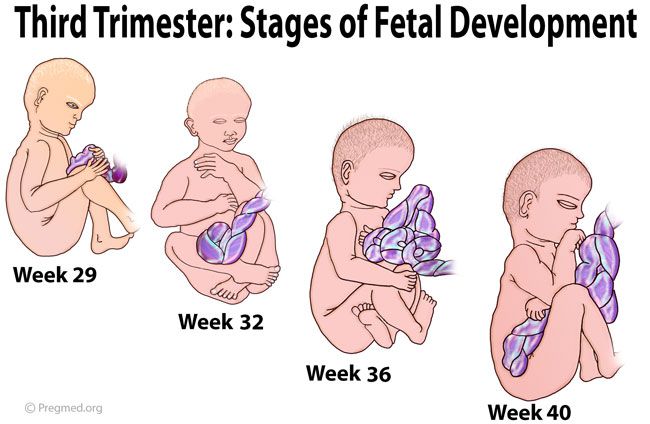
Bleeding
Spotting or light bleeding in your second trimester is normal. But call your care provider if you’re bleeding enough to soak through more than one pad, or if your bleeding is paired with strong abdominal pain or passing pieces of tissue.
When will I feel my baby move for the first time?
Another joy that comes in the second trimester is finally feeling your baby move. It feels like flutters in your tummy, but these flutters can also be confused with gas bubbles. That’s why it may be tough for you to distinguish between your baby’s first kicks or the chicken salad sandwich you ate for lunch. You may be able to tell the difference by 20 to 22 weeks.
If you don’t feel your baby kick, don’t panic. Your placenta may be located at the front of your uterus. This creates a pillow between you and your baby. In a few more weeks, your baby will grow big enough so you can feel his or her movements through your placenta pillow.
What fetal development occurs in the second trimester?
In addition to starting to move, your baby undergoes a lot of changes during these weeks.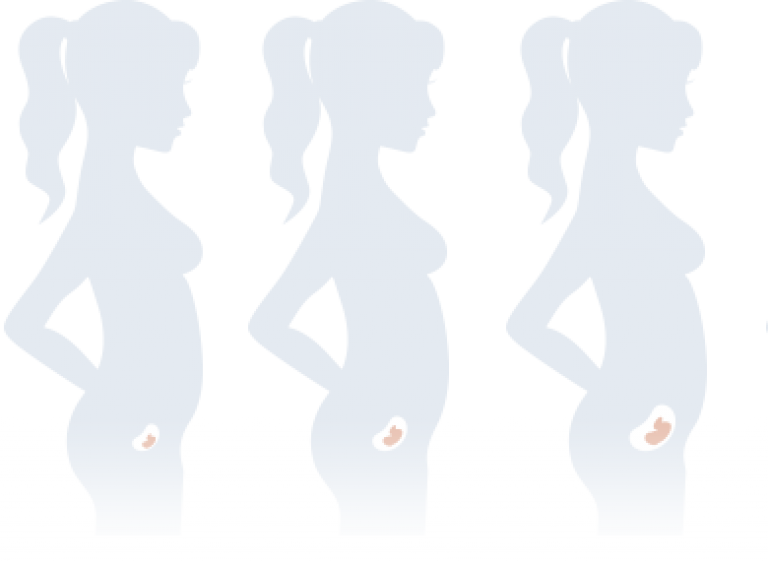 Their fingers, toes and facial features develop and become more defined. Baby’s nervous system starts working, they start to store fat and in the latter half of the trimester, their eyes will open. By the time you reach the third trimester of your pregnancy, your baby will even respond to stimuli.
Their fingers, toes and facial features develop and become more defined. Baby’s nervous system starts working, they start to store fat and in the latter half of the trimester, their eyes will open. By the time you reach the third trimester of your pregnancy, your baby will even respond to stimuli.
Other frequently asked questions
How should I sleep during the second trimester of pregnancy?
Until it becomes uncomfortable due to your baby bump, you can sleep on your stomach. Otherwise, you can start getting used to sleeping on either your left or right side.
Is it safe to have intercourse during the second trimester of pregnancy?
Totally, unless your care team has told you otherwise (and you can still ask if you want to be sure). Just listen to your body, do what’s comfortable, and stop if you feel pain.
How much weight will I gain during the second trimester?
If you were at a healthy weight pre-pregnancy, you might start to gain weight a little faster now than you did in your first trimester. Overall recommended weight gain depends on your starting weight and how much you gained in the first trimester.
Overall recommended weight gain depends on your starting weight and how much you gained in the first trimester.
Is it normal to pee a lot in the second trimester?
While you may have experienced frequent trips to the bathroom during first trimester, it’s common to get a break in the second trimester. Your body is now more adapted to the change in hormones, plus your growing uterus will rise in your abdomen and take off some pressure, so you won’t feel the need to pee as often.
In the third trimester, you’re more likely to feel pressure on your bladder and take more trips to the bathroom. However, it’s still normal to feel like you have to pee a lot during any time in your pregnancy. Talk with your doctor if you notice pain when you urinate, cloudy, foul-smelling or blood-tinged urine, or are experiencing severe incontinence.
Second trimester tests
Both your body and your baby are growing rapidly and changing fast. This means your provider will want to monitor the health of you and your baby even more.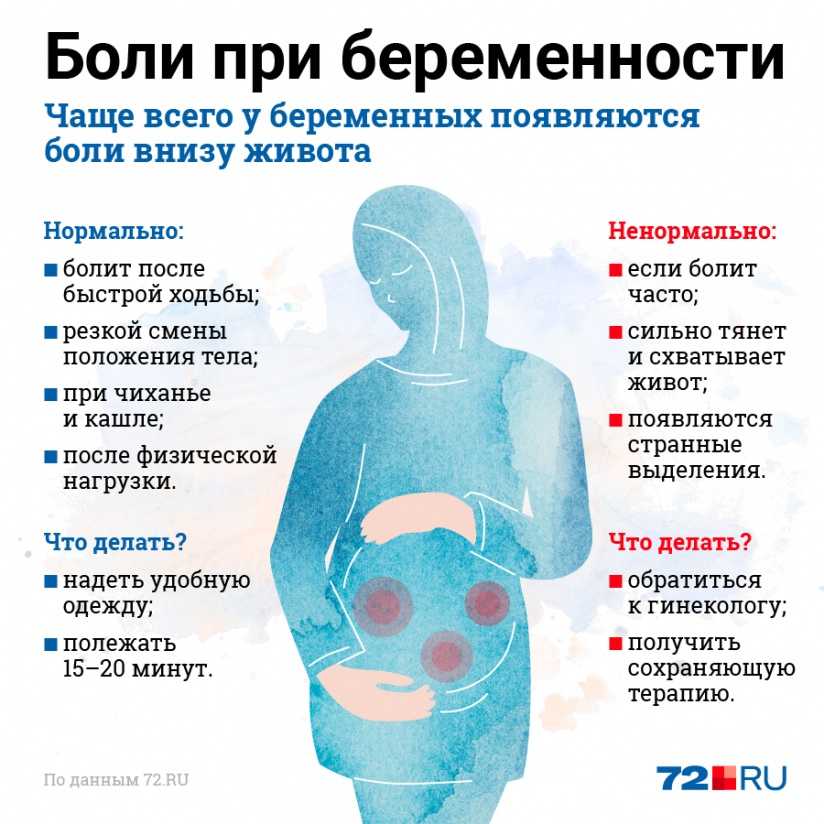 During your second trimester, there are some routine, as well as optional, tests including:
During your second trimester, there are some routine, as well as optional, tests including:
Ultrasound
You’ve probably heard your baby’s heartbeat during your regular appointments. But during your ultrasound, you’ll get the first actual look at your baby. This ultrasound is scheduled around 19 to 22 weeks. This anatomy scan takes a closer look at your baby’s brain, heart, facial features and bone structure to make sure your baby is developing normally. You can also use this ultrasound as an opportunity to find out if you are having a boy or a girl.
Gestational diabetes test
You’ll be scheduled for your gestational diabetes test around 24 to 28 weeks. There aren’t any symptoms associated with gestational diabetes, which is why taking this test is so important. During the test, you’ll drink a sugary juice and then we’ll monitor the glucose levels in your bloodstream. If your glucose levels are high, you’ll be asked to retake the test on another day. This second test will be longer and require you to fast beforehand.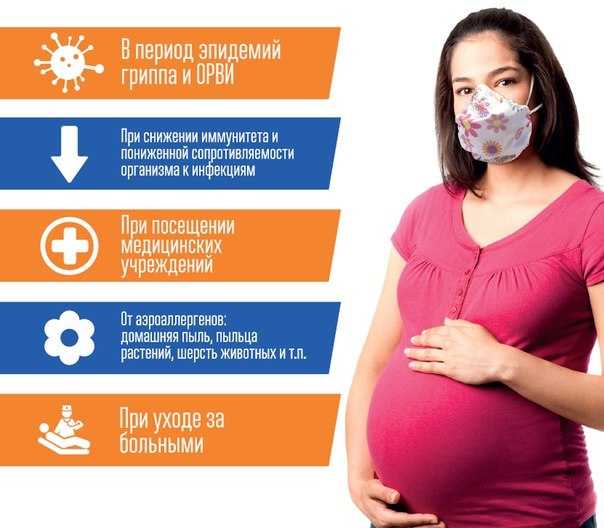
Anemia screening
Your blood vessels are opening during your second trimester and, as a result, the amount of blood pumping through your veins is increasing. When this happens, your red blood cell count could decrease and you could become anemic. This is quite common during pregnancy and it means you’ll probably need to add more iron and vitamins to your diet.
Genetic testing
These are optional screening tests that can be started as early as 11 weeks into your pregnancy. These tests include a blood draw to evaluate pregnancy hormones levels and may include an ultrasound. They can help determine if your baby has genetic abnormalities like Down syndrome or spina bifida.
Genetic tests may be recommended during your pregnancy if you are over age 35 or have other risk factors. It’s best to talk with your provider to find out more information and discuss the specific types of tests available. Then you can decide if there are any that are right for you.
Routine tests will likely be covered under your insurance benefits. In some instances, genetic screenings may not be covered. When in doubt, call your insurance provider to learn more about your specific benefits.
In some instances, genetic screenings may not be covered. When in doubt, call your insurance provider to learn more about your specific benefits.
One down, two to go
The second trimester is an exciting part of your pregnancy. You often feel better and have more energy, (which is super helpful as you begin to prepare the nursery or make a birth plan!). And of course, as your pregnancy progresses, don’t hesitate to ask your provider questions about your symptoms or what to expect as you approach your due date.
Second trimester discomforts | Pregnancy manual
Digestive system discomforts
When you're pregnant, hormones relax and slow intestinal movement. That makes food travel through the digestive system more slowly. This allows more nutrients to be absorbed. In addition, the growing uterus crowds the intestines and stomach. As a result, you can have heartburn, indigestion and constipation.
Heartburn
When the muscle at the top of your stomach relaxes, acid can flow into your esophagus (the tube that passes food from your mouth to your stomach). This causes a burning feeling in your chest and throat. To help reduce this effect:
This causes a burning feeling in your chest and throat. To help reduce this effect:
- Eat small meals and snacks often. Do not overeat.
- Drink liquids between meals rather than with meals.
- Sip milk, hot tea or water.
- Avoid fried or fatty foods, spicy foods, and caffeine.
- Keep a food diary to help you identify other foods that give you heartburn.
- Avoid lying down or bending over for two hours after eating.
- When you do lie down, rest on your side and prop your head and shoulders with pillows.
- Raise the head of your bed on small blocks to help prevent nighttime heartburn.
- Ask your health care provider about using an antacid.
Indigestion
To prevent the queasy and gassy feeling of indigestion, try these suggestions:
- Avoid foods that produce gas.
- Eat small, frequent meals.
- Get regular exercise.
- If you have bloating, ask your health care provider about taking medicine to reduce gas.
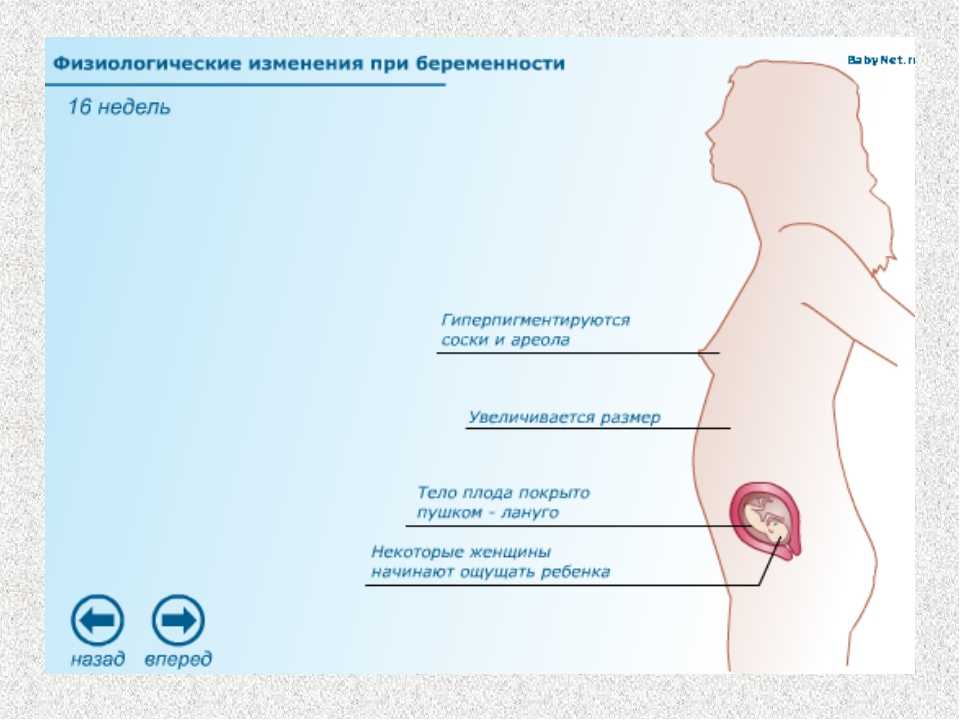
Constipation
To help avoid constipation:
- Drink eight to 10 glasses of liquids (at least 64 ounces) a day.
- Try a hot or warm drink first thing in the morning.
- Eat high-fiber cereals, whole grains, fruits (such as pears, mangoes, plums, prunes, beets and peaches), vegetables and legumes.
- Walk or exercise daily.
- Talk with your health care provider before you take a laxative.
Other discomforts
Varicose veins
The pressure of a larger uterus and baby, increased blood volume, and increased relaxation of blood vessels can result in varicose veins. To help reduce them:
- Avoid standing for long periods of time.
- Change positions often when you are standing or sitting. Gently shifting your weight from foot to foot keeps the blood moving.
- Don't cross your legs when you sit.
- Avoid wearing knee-high stockings that can restrict blood flow. Consider wearing compression stockings.

- Swim or walk to improve the circulation in your legs.
Hemorrhoids
Hemorrhoids are varicose veins in the rectum and anus. To reduce the chance of getting them or to cope with them:
- Eat foods high in fiber.
- Drink plenty of liquids.
- Avoid straining when you are having a bowel movement.
- Exercise regularly.
- Apply compresses of witch hazel or Tucks® for relief.
Breathlessness
You may sometimes feel breathless when you climb the stairs or exert yourself. Your body is adjusting to accommodate a growing uterus and movement of other organs in your abdominal cavity. To help your breathing:
- Take your time going up stairs.
- Carry smaller packages and grocery bags.
- Adjust your exercise routine. Go slower and cover shorter distances.
If you are having trouble getting your breath or if it is hard to breathe, call your health care provider.
Round ligament pain
A round ligament anchors your uterus on the right and left side. If you move suddenly, especially when getting up or raising your arms, you can feel a sharp tug. Overstretching these ligaments causes this pain. Moving slowly can help prevent most of this overstretching. It can also be helpful to support your abdomen when coughing, sneezing or changing positions.
Ask your health care provider about simple maternity support garments that support the round ligament if you have ongoing discomfort.
Leg cramps
Circulation changes can also cause leg cramps or "charley horses." Exercises like walking and swimming help improve circulation and can reduce cramps in your calves. In addition, you can do foot pumps and stretches.
Foot pump
If you have not had leg cramps, do a series of this exercise several times a day. You can do this exercise while sitting or lying on your side. You can exercise both legs at the same time or separately.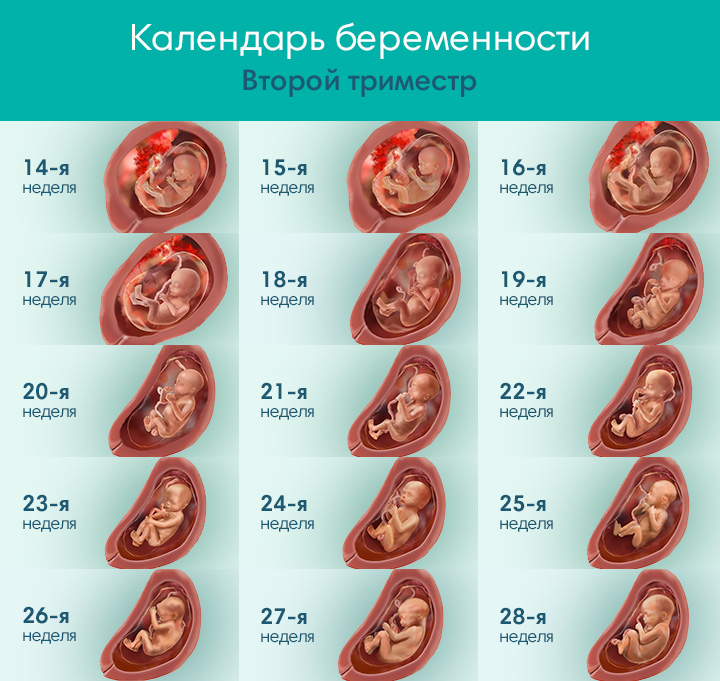
- Point your heel and hold for five seconds.
- Point your toe and hold for five seconds.
- Repeat the cycle five times. If you've started having leg cramps, don't point your toe.
- Point your heel and hold for five seconds.
- Release the point and return your foot to its usual position for five seconds.
- Repeat the heel point and hold.
- Repeat the cycle five times.
Runner's stretch
- Stand a little less than an arm's length from a wall.
- Step toward the wall with your right foot and keep your right knee bent. Keep your left leg straight.
- Put the palms of your hands on the wall. Bend your elbows and lean forward over the front leg.
- Keep both heels on the floor.
- Lean until you feel a gentle pull in your left calf. Hold that stretch for the count of 10.
- Switch legs.
- Stretch each leg five times.
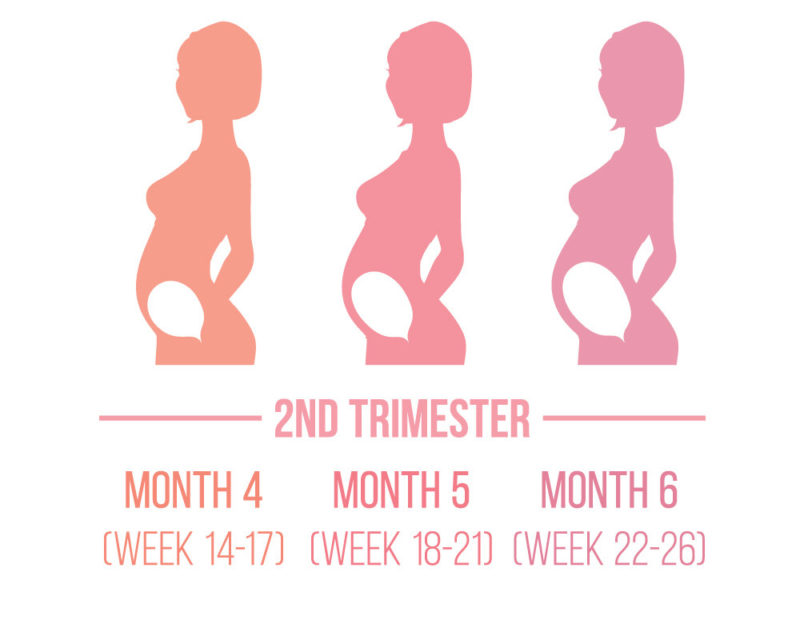
You can also use a runner's stretch to relieve a cramp. Stretch the leg that is having the cramp. If you can't stand during the cramp, point your heel as firmly as you can. You can also have someone help you point your heel.
To reduce nighttime leg cramps:
- Keep your legs warm.
- Avoid pointing your toes when stretching your legs in bed.
- Make sure you are getting the calcium you need.
- Limit processed snack foods and soft drinks.
- Eat a diet rich in magnesium (beans, nuts, dark leafy greens, bananas).
To reduce nighttime leg cramps:
- Keep your legs warm.
- Avoid pointing your toes when stretching your legs in bed.
- Make sure you are getting the calcium you need.
- Limit processed snack food and soft drinks.
second trimester - ON Clinic's blog
In the second trimester of pregnancy, a woman's body continues to change.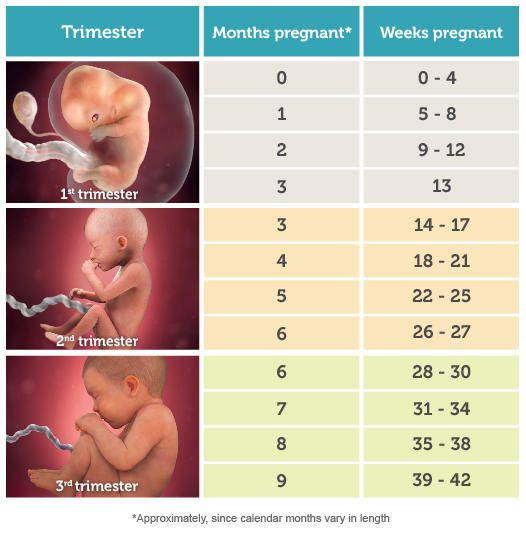 This is the period from 13 to 26 weeks. Every day, the baby in the womb grows and develops, which leads to an increase in the abdomen.
This is the period from 13 to 26 weeks. Every day, the baby in the womb grows and develops, which leads to an increase in the abdomen.
The second trimester is considered the best time to prepare for the arrival of a baby. Most women who did not feel very well in the first trimester, starting from the 13th week, note a significant improvement in their condition. Every day, nausea and vomiting in the morning happen less and less, although there are exceptions when unpleasant symptoms remain. The expectant mother has more energy and strength, the incidence of mood swings is reduced, as the level of hormones becomes more balanced. nine0003
In the second trimester, a woman's body weight grows even faster. There is a need for special clothes for pregnant women.
Will my breasts continue to grow?
Yes, breasts grow at the same rate during the second trimester due to the increase in the volume of the mammary glands and the deposition of fat. It is these changes that prepare the expectant mother to feed her baby.
The skin on and around the nipples will darken. A woman may notice the appearance of peculiar tubercles around the nipples. These are glands that secrete a special substance that prevents the skin of the nipples from drying out. nine0003
A yellowish liquid, an intermediate form of milk (colostrum), may also begin to be released, which plays an important role in the first days of a baby's life. Having a laxative property, colostrum helps the newborn to get rid of meconium (original feces), which consists of epithelial cells digested in utero, prenatal hair, mucus, amniotic fluid, bile and water.
What are stretch marks and can they be prevented?
Some parts of the pregnant woman's body naturally grow and enlarge. In such places, the skin becomes taut, and the elastic fibers underneath are torn. This is how stretch marks are formed - stripes with dents on the skin. Stretch marks usually appear on the abdomen and chest, the areas most prone to growth during pregnancy.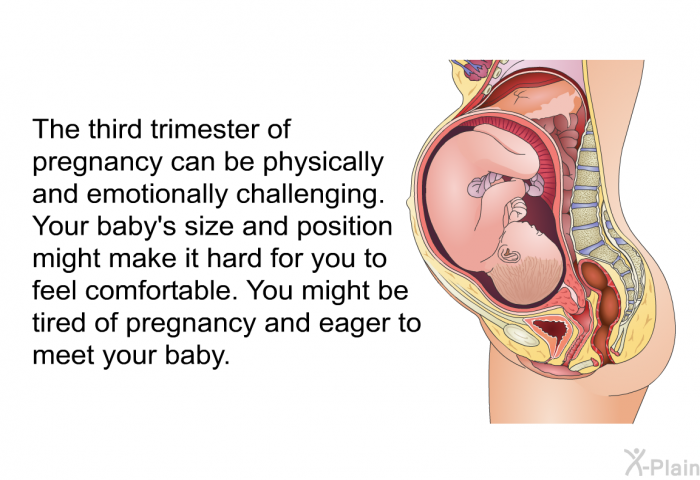 nine0003
nine0003
This is a fairly common problem, although not every pregnant woman develops stretch marks. It is impossible to completely prevent the appearance of unpleasant stripes on the skin.
The main thing to do is to control the weight. Do not gain more weight than the doctor recommends. There are many lotions and oils in the cosmetics industry to prevent stretch marks, but these products have not been proven to work. However, it is worth noting that keeping the skin well hydrated reduces itching. nine0003
Stretch marks usually become less noticeable after childbirth. In some cases, they disappear completely.
What other changes can be expected?
Not all pregnant women worry about skin problems. Usually such changes completely disappear or decrease in their intensity after the birth of a child. Common skin problems during pregnancy include:
- dry skin on the abdomen;
- pimples;
- increased sensitivity to the sun. Because of this, the skin burns much faster in the sun.
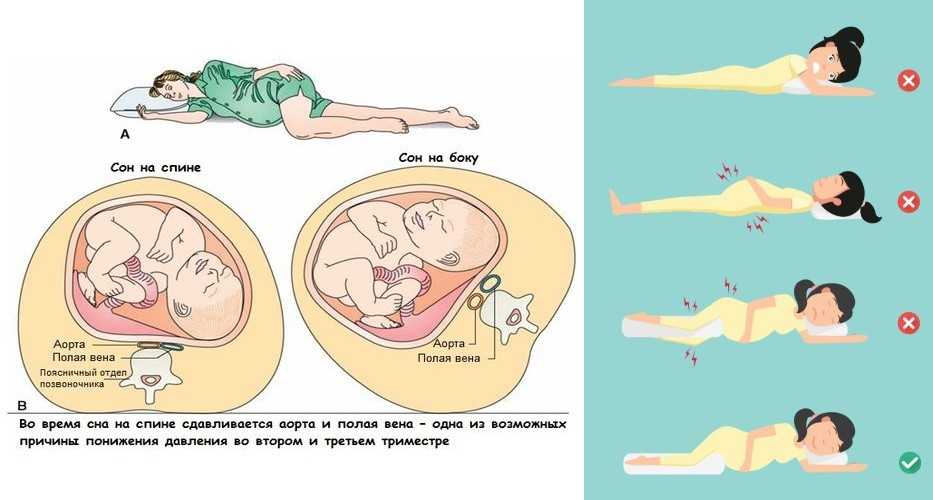 When spending a lot of time outdoors, you should always take sunscreen with you; nine0032
When spending a lot of time outdoors, you should always take sunscreen with you; nine0032 - a dark line (“linea nigra”) from the navel to the pubis right in the middle of the abdomen and dark spots on the face (sometimes called the “mask of pregnancy”). This is melasma. It occurs due to the action of estrogen (a hormone responsible for preparing a woman's body for childbirth and then for lactation).
Dry skin on the abdomen is often accompanied by itching. However, this can be caused by cholestasis (decreased flow of bile from the liver) and gestational diabetes (a violation of carbohydrate metabolism that occurs during pregnancy). You should be careful with these symptoms and consult a doctor if you suspect any complications. nine0003
What other changes can be expected in the second trimester?
Pregnant women in the second trimester often suffer from pain in the legs, cramps during sleep. Such phenomena are associated with the pressure exerted by the baby in the womb.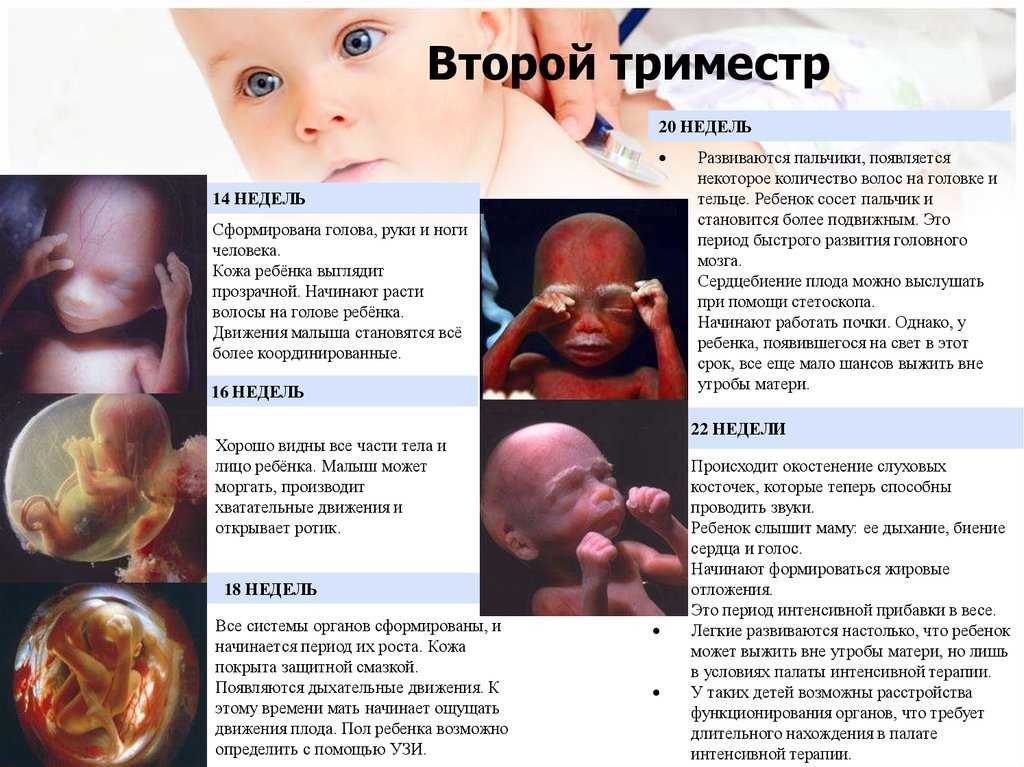 It compresses the nerve endings and vessels that supply blood to the lower limbs. To avoid pain and cramps, it is recommended to sleep on your side, not on your back.
It compresses the nerve endings and vessels that supply blood to the lower limbs. To avoid pain and cramps, it is recommended to sleep on your side, not on your back.
A more dangerous symptom is deep vein thrombosis. A thrombus is a blood clot in a vessel that occurs due to disorders in the coagulation system. The main symptoms of the disease are pain and swelling of one lower limb. If you notice such symptoms, you should immediately consult with your doctor. nine0003
Puffiness is one of the most common problems in pregnancy. The ankles, hands, and face are usually swollen. During gestation, the volume of fluid in the mother's body doubles. This is the circulatory system of the fetus, and amniotic fluid. In addition, due to hormonal changes in the tissues, sodium is retained, which tends to retain water. Edema can appear at any stage of pregnancy, but most often they occur at the end of the second trimester.
Back pain due to the growing belly of the pregnant woman.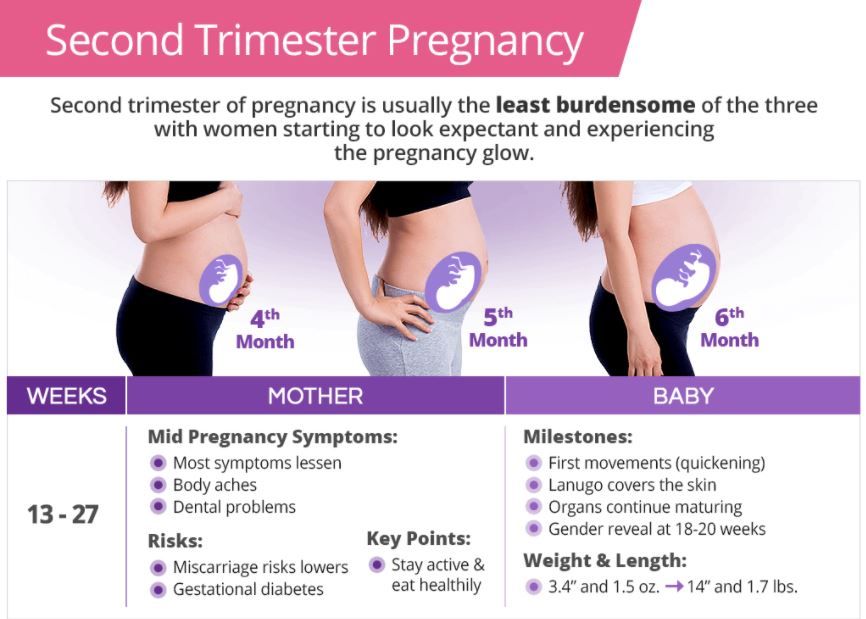 It takes extra effort to keep it going. And this is against the background of relaxation of the ligaments that hold the bones of the pelvis and hips together. This is due to specially secreted hormones that prepare the woman's body for childbirth, thus making the birth canal more mobile. nine0003
It takes extra effort to keep it going. And this is against the background of relaxation of the ligaments that hold the bones of the pelvis and hips together. This is due to specially secreted hormones that prepare the woman's body for childbirth, thus making the birth canal more mobile. nine0003
A pregnant woman has abdominal pain. The muscles and ligaments that support the uterus stretch as it grows. This causes mild pain or spasms.
Sometimes pregnant women report tooth decay. A lot of calcium is used to build a child's skeleton. When there is not enough calcium, the mother's special hormones are activated, and calcium is washed out of the woman's bones and teeth. In addition, acidity changes in the oral cavity, which increases the risk of infection and the development of caries. To prevent this, it is necessary to visit the dentist regularly throughout pregnancy. nine0003
The occurrence of nasal congestion, nosebleeds and bleeding gums is associated with increased blood flow in the mucous membranes of the nasal passages and oral cavity.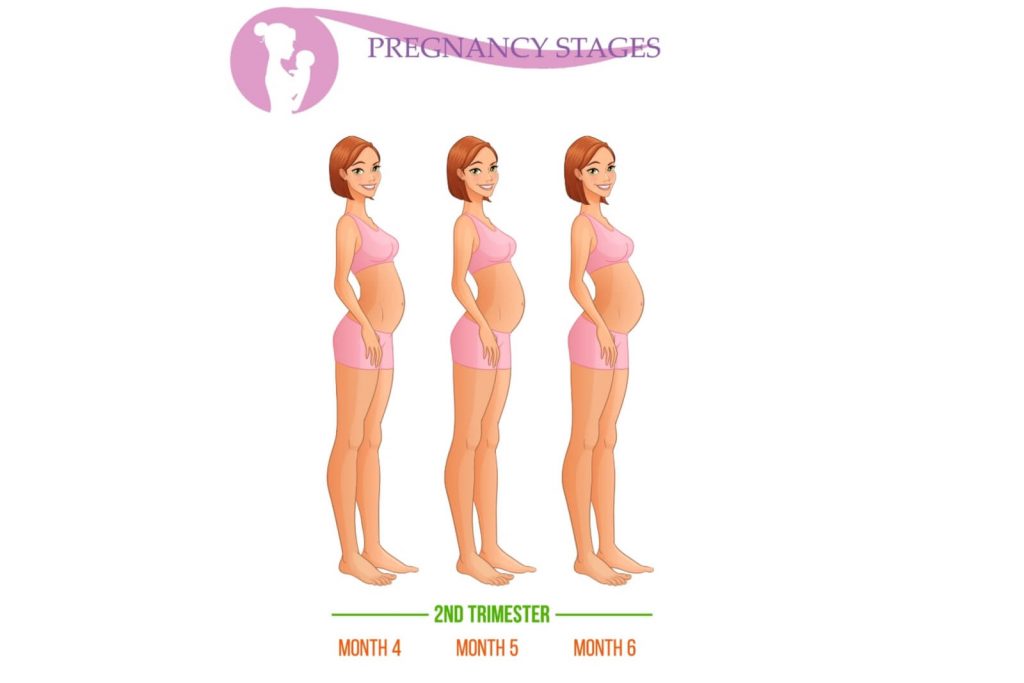
Heartburn usually starts, if it was not there, or worsens in the second trimester of pregnancy. Some may never encounter it. The uterus rapidly increases in volume, thereby pressing on the stomach, due to which food and stomach acid enter the esophagus, which provokes discomfort.
In the second trimester of pregnancy, there is a risk of catching urinary tract infections. The outflow of urine slows down due to hormonal changes, while the bladder is not able to empty completely, because the enlarged uterus presses on it. Urinary tract diseases without proper treatment can cause premature birth. If you have any signs of infection, you need to make an appointment with your doctor: the urge to urinate frequently, burning, the presence of blood, or an unpleasant, persistent smell of urine. nine0003
Braxton-Hicks contractions (“false contractions”) are contractions of the muscles of the uterus. Thus, the uterus prepares for childbirth. Such contractions make the abdomen tense and rigid, which causes discomfort. The contractions are irregular in time and should pass within a few minutes. You should call your doctor if the contractions become regular, painful, and do not go away with a change in position. This condition may indicate the onset of premature birth.
The contractions are irregular in time and should pass within a few minutes. You should call your doctor if the contractions become regular, painful, and do not go away with a change in position. This condition may indicate the onset of premature birth.
When will I feel my baby move? nine0009
Just in the middle of the second trimester, a pregnant woman begins to feel her baby. The first thrusts are more like fluttering movements deep in the abdomen. Over time, the sensations intensify.
Of course, the child moved before that, but it was very weak, almost imperceptible. Usually, women who give birth for the second or third time can feel the first tremors much earlier, because they are already familiar with this feeling. The day of the first shocks should be noted on the calendar and the doctor should be told about it at the next consultation so that he can transfer the data to the pregnancy card. nine0003
Will my interest in sex return?
Symptoms such as morning sickness and vomiting, frequent mood swings and lack of energy can make a woman less sexually active. She simply does not want sex because of the emotional or physical condition and fatigue. However, many women note a return of the desire to have sex in the second trimester.
She simply does not want sex because of the emotional or physical condition and fatigue. However, many women note a return of the desire to have sex in the second trimester.
Doctors say that sex is not contraindicated regardless of the duration of pregnancy. But only the attending physician can say for sure. There are individual situations when sex is forbidden: threatened miscarriage, multiple pregnancies, bleeding. nine0003
What to ask the doctor during the visit?
It is necessary to make a scheduled visit to the doctor during the entire period of pregnancy. Usually - once a month. What questions should you ask a gynecologist?
- How to change the body in the second trimester of pregnancy?
- How will the second trimester affect your emotional state?
- Are new symptoms and signs cause for concern?
- How can symptoms be reduced or eliminated? What medications are allowed and which are not? nine0032
- What complications can follow these symptoms?
- Should I be afraid of edema? How to reduce swelling?
- Is it normal to let milk out of the breast during pregnancy?
- Is it better to sleep on your side or on your back?
- Is it safe to have sex?
Don't be afraid to ask questions that worry you. It is better to clarify incomprehensible points so that there is no room for concern. Moreover, timely detection of dangerous symptoms will help to bear a healthy child and prevent the development of complications. nine0003
It is better to clarify incomprehensible points so that there is no room for concern. Moreover, timely detection of dangerous symptoms will help to bear a healthy child and prevent the development of complications. nine0003
Article rating:
4 out of 5 based on 5 ratings
Ask your question to the gynecologist
"ON Clinic"
2nd trimester of pregnancy: what happens to the fetus
2nd trimester of pregnancy: what happens to the fetus - Private maternity hospital Ekaterininskaya ClinicsMost women enjoy the 2nd trimester of pregnancy more than the first, with the disappearance of morning sickness, breast tenderness and fatigue. But be prepared for some other symptoms to appear! nine0003
- Pain. As a result of stretching of the tissues of the body, you may experience pain in the sides and under the abdomen. Weight gain can cause back pain and leg cramps. The doctor will advise you on simple exercises for such cases.
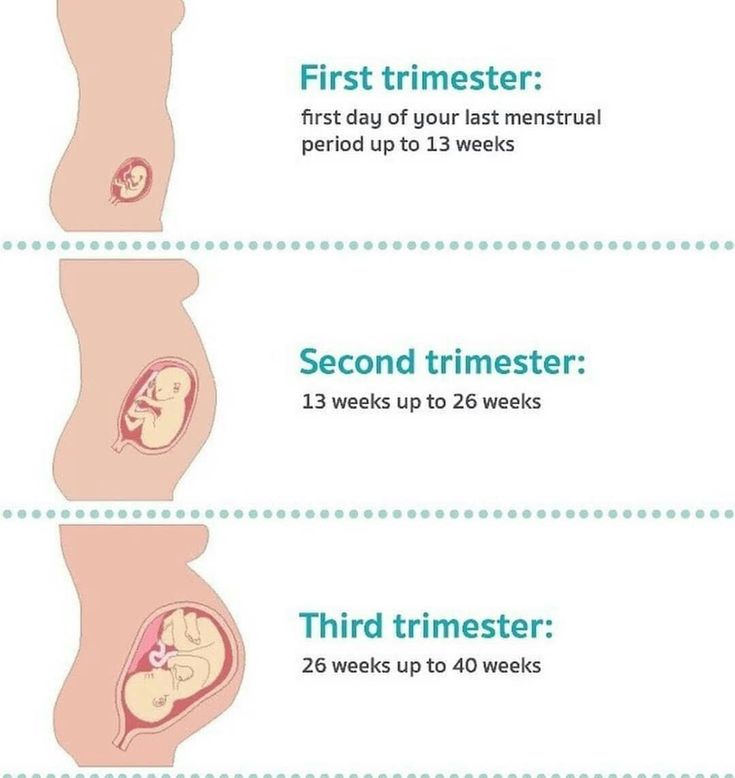
- Stuffy nose. Increased hormone levels can lead to nasal congestion and nosebleeds.
- Soft gums. Your gums tend to bleed, so oral hygiene requires special attention and careful brushing. nine0032
- Skin itching. The skin of the abdomen may itch as a result of stretching associated with the growth of the child. Try to use a moisturizer daily to avoid stretch marks.
- Varicose veins and hemorrhoids. During pregnancy, you will be more susceptible to varicose veins and hemorrhoids. Try not to stand or sit for too long, and avoid crossing your legs while sitting. If discomfort or pain occurs in the anus, the doctor may prescribe a remedy for hemorrhoids. nine0032
- Vaginal discharge. A white, thin vaginal discharge called leucorrhea is normal during this period of pregnancy. These secretions help keep the vagina healthy. If you find discharge of a different type or color, contact your doctor for advice.
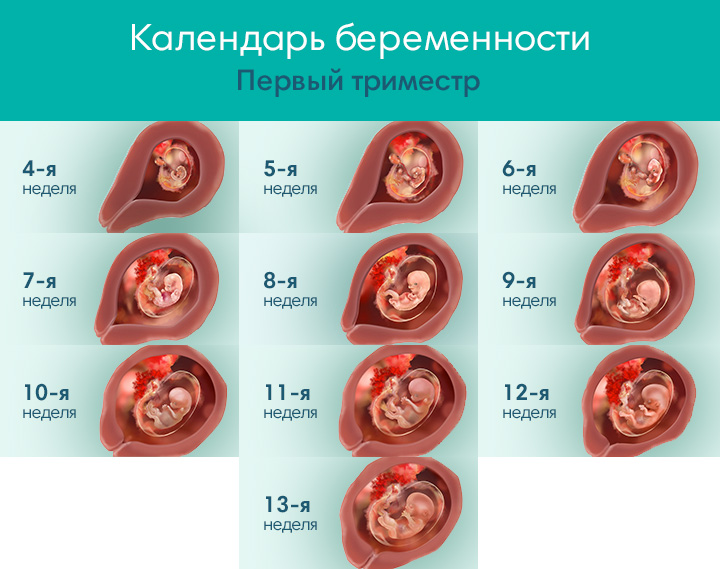
- Impaired skin pigmentation. Pregnancy hormones may contribute to the appearance of dark spots on the face and abdomen. The sun can exacerbate the appearance of spots, so use sunscreen when you go outside. Sun exposure without skin protection is contraindicated! nine0032
- Shortness of breath. As your lungs allow more oxygen to meet your baby's needs, you may experience shortness of breath or a faster rate of breathing.
- Increased appetite. As your child grows, you may feel hungry all the time, but there is no need to "eat for two". If you need to snack, choose healthy foods like fruit or yogurt.
2nd trimester milestones
- You may feel your baby move for the first time between 18 and 20 weeks of pregnancy. This phenomenon is called "revival" and is initially felt as a flutter in the abdomen.
- As your baby grows, your belly will grow.
2nd trimester baby development
End of 2nd trimester:
- Your baby moves and responds to touch and sound.
